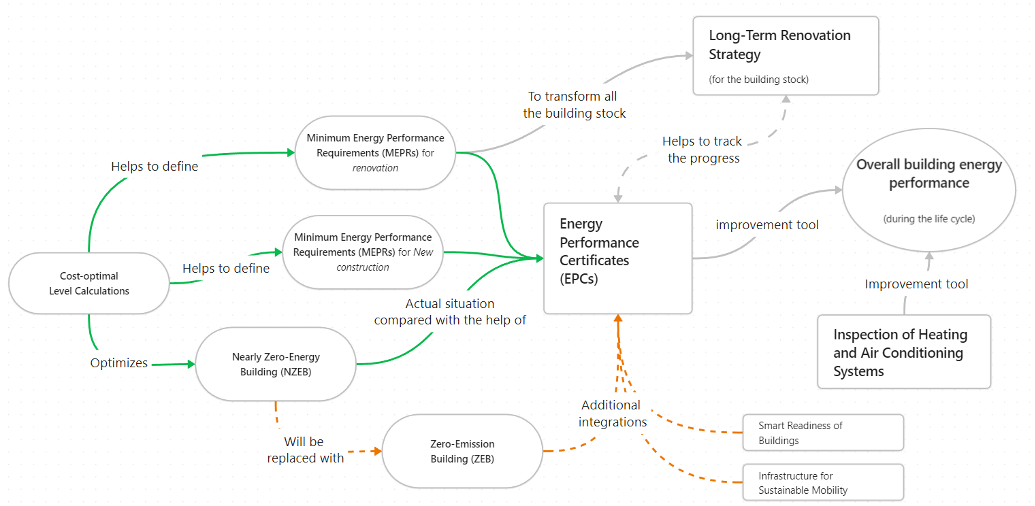Energy Performance of Buildings
The Landscape of the Energy Performance of Building Regulations
Building regulations serve as critical pathways to achieving energy efficiency and sustainability within the built environment. The intricate landscape of these regulations is composed of multifaceted elements, each playing a distinct yet interconnected role in driving the collective energy performance of the building stock. This chapter elucidates the synergistic framework of regulations that, while inspired by the European Union’s Energy Performance of Buildings Directive (EPBD), are presented here as a compendium of best practices for the Central Asian context.
These regulatory components, from cost-optimal level calculations to long-term renovation strategies, form a cohesive network aimed at not just compliance but at fostering an ambitious shift towards nearly zero-energy buildings (NZEB) and eventually, zero-emission buildings (ZEB). Illustrated through the accompanying visual representation, the chapter navigates the interplay between foundational assessments, performance certifications, and the visionary end-goals of a decarbonized building stock. By doing so, it underlines a comprehensive approach that is not merely prescriptive but also transformative, ensuring that energy efficiency and low-carbon objectives are ingrained in the lifecycle of buildings.
Furthermore, it will highlight the added dimension of sustainable mobility infrastructure, showcasing how modern building regulations extend their reach beyond the confines of walls to encapsulate the broader ecosystem of sustainable living. Thus, we embark on a deep dive into the dynamic realm of building regulations, where energy performance is not the end goal but a gateway to a sustainable future.
Elements helping to improve energy performance of the buildings
The main elements under the EU Energy Performance of Buildings Directive (EPBD) are interconnected components designed to collectively enhance the energy performance of building stock within the European Union. Here’s a simplified breakdown of how they relate to one another:
- Cost-optimal Level Calculations: This involves calculating the life-cycle cost of buildings or building units to identify the cost-optimal level of energy performance. This ensures that minimum energy performance requirements (MEPRs) are set to balance upfront costs with long-term savings.
- Minimum Energy Performance Requirements (MEPRs): These are the baseline energy efficiency standards that new or existing buildings undergoing significant renovation must meet. They are crucial for reducing energy consumption and promoting energy use from renewable sources.
- Energy Performance Certificates (EPCs): EPCs measure a building’s energy performance and make recommendations for improvement. They are essential tools for informing building owners, potential buyers, or tenants about a building’s energy efficiency.
- Nearly Zero-Energy Building (NZEB): NZEBs are highly energy-efficient buildings with very low annual energy demand, significantly covered by energy from renewable sources produced on-site or nearby.
- Long-Term Renovation Strategy: Member states are required to formulate a strategy to support the renovation of the national stock of residential and non-residential buildings, both public and private, into a highly energy-efficient and decarbonised building stock by 2050, facilitating the cost-effective transformation of existing buildings into NZEBs.
- Zero-Emission Building (ZEB): This concept extends beyond NZEBs by aiming to balance the emissions produced and the renewable energy generated on-site over a specified period, targeting a net-zero carbon footprint.
- Smart Readiness of Buildings: This refers to buildings’ capability to adapt their operation to the needs of the occupant, optimizing energy consumption and contributing to the overall efficiency of the energy system.
- Infrastructure for Sustainable Mobility: The EPBD promotes the inclusion of features that support sustainable mobility, such as electric vehicle charging stations, to reduce the carbon footprint associated with transportation.
- Inspection of Heating and Air Conditioning Systems: Regular inspections of heating and air conditioning systems ensure they operate efficiently, maintain indoor air quality, and do not consume excessive energy.
Interrelations and Interactions
Foundation and Implementation: Cost-optimal level calculations and MEPRs serve as the foundational framework guiding building design, construction, and renovation towards higher energy efficiency. EPCs are a transparency tool that provides visibility into a building’s energy performance and encourages improvements.
Compliance and Beyond Inspections of heating and air conditioning systems ensure compliance with MEPRs while also promoting operational efficiency that supports NZEB and ZEB objectives. Towards Net-Zero: NZEB and ZEB are complementary concepts that drive the ambition of the EPBD. They represent targets for the energy performance of individual buildings, with ZEB adding a focus on the balance of emissions over time. Both concepts rely on foundational elements like MEPRs and cost-optimal calculations to set ambitious yet achievable standards.
Integration with Energy Systems: Buildings’ and infrastructure’s smart readiness for sustainable mobility are forward-looking elements that integrate buildings into the wider energy system. They support the transition to a smarter, more flexible energy system by enabling buildings to act as active energy players rather than passive consumers. This integration is key for achieving long-term renovation strategies and the overall decarbonisation of the building stock.
Cross-support: Each element directly or indirectly supports the others. For example, the smart readiness of buildings can enhance the efficiency and effectiveness of heating and air conditioning systems, contribute to the NZEB and ZEB goals by optimising energy use, and support sustainable mobility by integrating electric vehicle charging infrastructure.
These elements create a comprehensive and cohesive approach to improving buildings’ energy performance. This reflects the EPBD’s holistic view of buildings as structures and key components in the EU’s energy and climate objectives. The EPBD facilitates the transition towards a more energy-efficient and low-carbon building stock by addressing physical and operational aspects.
